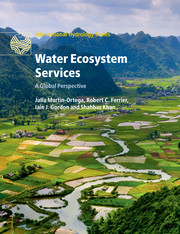Book contents
- Frontmatter
- Contents
- List of contributors
- Preface
- 1 Introduction
- 2 What defines ecosystem services-based approaches?
- Part I Addressing global challenges
- Part II Applying frameworks for water management and biodiversity conservation under an ecosystem services-based approach
- Part III Assessing water ecosystem services
- 9 The first United Kingdom's National Ecosystem Assessment and beyond
- 10 Using an ecosystem services-based approach to measure the benefits of reducing diversions of freshwater: a case study in the Murray-Darling basin, Australia
- 11 An ecosystem services-based approach to integrated regional catchment management: the South East Queensland experience
- 12 Policy support systems for the development of benefit-sharing mechanisms for water-related ecosystem services
- 13 Assessing biophysical and economic dimensions of societal value: an example for water ecosystem services in Madagascar
- 14 Rapid land use change impacts on coastal ecosystem services: a South Korean case study
- Part IV Broadening the perspective
- Index
- Plate Section
- References
14 - Rapid land use change impacts on coastal ecosystem services: a South Korean case study
from Part III - Assessing water ecosystem services
Published online by Cambridge University Press: 05 May 2015
- Frontmatter
- Contents
- List of contributors
- Preface
- 1 Introduction
- 2 What defines ecosystem services-based approaches?
- Part I Addressing global challenges
- Part II Applying frameworks for water management and biodiversity conservation under an ecosystem services-based approach
- Part III Assessing water ecosystem services
- 9 The first United Kingdom's National Ecosystem Assessment and beyond
- 10 Using an ecosystem services-based approach to measure the benefits of reducing diversions of freshwater: a case study in the Murray-Darling basin, Australia
- 11 An ecosystem services-based approach to integrated regional catchment management: the South East Queensland experience
- 12 Policy support systems for the development of benefit-sharing mechanisms for water-related ecosystem services
- 13 Assessing biophysical and economic dimensions of societal value: an example for water ecosystem services in Madagascar
- 14 Rapid land use change impacts on coastal ecosystem services: a South Korean case study
- Part IV Broadening the perspective
- Index
- Plate Section
- References
Summary
14.1 INTRODUCTION
Coastal zones occupy a relatively small portion of the global land surface, but play a key role in various aspects of the biophysical settings of ecosystems and human activities. Coastal areas form the interface of land, freshwater, and sea, where terrestrial and marine ecosystems and socio-economic processes are linked. As such, coastal areas are one of the most ecologically and economically productive areas on Earth, providing multiple ecosystem services, including water quality amelioration, accumulation, and conversion of carbon and nutrients, protection against floods and tidal inundation, and the provision of wildlife habitat. They also provide fisheries, agricultural production, living spaces, water resources for industry, and recreational activities. More than half of the world's population lives within 200 kilometres of a coast (Hinrichsen 1998), many of them in coastal cities. Overall, coastal zones produce more than 60% of the economic value of the Earth (Martínez et al. 2007).
Both population growth and climate change increase the importance of coastal ecosystem services and yet, paradoxically, many coastal areas have been significantly degraded, primarily because of ongoing land development driven by population growth (Hong et al. 2010). For example, expanding urban development has caused land subsidence in the Pearl River delta in China (Wang et al. 2012). Additionally, globalization of trade in natural commodities, such as shrimp and oysters, has promoted the over-exploitation of these resources, negatively affecting the regulating ecosystem services, and species diversity more generally (Vermaat et al. 2012). Together with the predicted rise in sea levels caused by global climate change, coastal ecosystems are now facing many challenges associated with changes in land cover and land intensification that result in nitrogen enrichment, exposure to toxins, and alteration of hydrological regimes. Thus, maintaining the functions and integrity of coastal ecosystems through land use and development planning in a changing climate has become a primary policy issue in coastal ecosystem-based management (Barbier et al. 2008).
- Type
- Chapter
- Information
- Water Ecosystem ServicesA Global Perspective, pp. 119 - 126Publisher: Cambridge University PressPrint publication year: 2015



